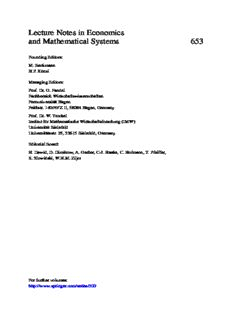
Network Economics and the Allocation of Savings: A Model of Peering in the Voice-over-IP Telecommunications Market PDF
Preview Network Economics and the Allocation of Savings: A Model of Peering in the Voice-over-IP Telecommunications Market
Lecture Notes in Economics and Mathematical Systems 653 FoundingEditors: M.Beckmann H.P.Ku¨nzi ManagingEditors: Prof.Dr.G.Fandel FachbereichWirtschaftswissenschaften Fernuniversita¨tHagen Feithstr.140/AVZII,58084Hagen,Germany Prof.Dr.W.Trockel Institutfu¨rMathematischeWirtschaftsforschung(IMW) Universita¨tBielefeld Universita¨tsstr.25,33615Bielefeld,Germany EditorialBoard: H.Dawid,D.Dimitrow,A.Gerber,C-J.Haake,C.Hofmann,T.Pfeiffer, R.Slowin´ski,W.H.M.Zijm Forfurthervolumes: http://www.springer.com/series/300 Philipp Servatius Network Economics and the Allocation of Savings A Model of Peering in the Voice-over-IP Telecommunications Market 123 PhilippServatius Universite´deFribourg DepartmentofQuantitativeEconomics Bd.dePe´rolles90 1700Fribourg Switzerland [email protected] ISSN0075-8442 ISBN978-3-642-21095-2 e-ISBN978-3-642-21096-9 DOI10.1007/978-3-642-21096-9 SpringerHeidelbergDordrechtLondonNewYork LibraryofCongressControlNumber:2011936793 ©Springer-VerlagBerlinHeidelberg2012 Thisworkissubjecttocopyright.Allrightsarereserved,whetherthewholeorpartofthematerialis concerned,specificallytherightsoftranslation,reprinting,reuseofillustrations,recitation,broadcasting, reproductiononmicrofilmorinanyotherway,andstorageindatabanks.Duplicationofthispublication orpartsthereofispermittedonlyundertheprovisionsoftheGermanCopyrightLawofSeptember9, 1965,initscurrentversion,andpermissionforusemustalwaysbeobtainedfromSpringer.Violations areliabletoprosecutionundertheGermanCopyrightLaw. Theuseofgeneral descriptive names,registered names, trademarks, etc. inthis publication does not imply,evenintheabsenceofaspecificstatement,thatsuchnamesareexemptfromtherelevantprotective lawsandregulationsandthereforefreeforgeneraluse. Coverdesign:eStudioCalamarS.L. Printedonacid-freepaper SpringerispartofSpringerScience+BusinessMedia(www.springer.com) In lovingmemoryof PoldiReinl 22.11.1977– 28.12.2007 Preface The author would like to express the utmost gratitude to everybody who has contributedtothis thesisin oneway oranother.As thereare certainlymanymore such individuals than I could reasonably accommodate here, I list only the most immediateones. Firstandforemost,Iwouldliketothankmymother,BrigitteServatius.Shehas alwaysofferedheradviceandsupportedmyendeavors,mostimportantlybyletting allfinaldecisionsrestwithme.Growingup(thoughsomechallengethisisindeed accomplished)she gavemeallthe offreedomI desiredandwith itthegreatestof allgoods:TheconfidencethatIwouldchoosetodotherightthing,or,asoftenas thiscouldnotbedeterminedapriori,avoidobviouslywrongchoices.Lookingback, Icouldnothavewantedmuchmore. Next, I want to thank all my of close friends. Countless hours spent in their company pushed my productivity and endowed me with the necessary energy to endure.Namesshallnotbenecessary,youknowwhoyouare. Also, I am very grateful for the support of my colleagues at the various institutionsthatcontributedto mydoctoraleducation.InparticularIwouldliketo mentionDr.Kazuhiko“Shiofuki”Kakamu,withwhomInotonlysharedanofficeat theInstituteforAdvancedStudiesinViennabutalsoencounteredmanychallenges there. No less Dr. Barbara von Schnurbein, ne´e Styczynska, my colleague at the ChairofMicroeconomicsinFribourg;toherIamindebtedformanyaconstructive criticismandforanatmosphereinourofficethatwassecondtonone.AlsoDanielle Martin, then assistant at the Chair of Statistics, who has occasionally let me take advantageof her superb math skills should notgo unmentioned.The same is true forBobo,SutiandYolanda. ThisdissertationwasfinalizedwhilevisitingECARESattheUniversite´Librede Bruxelles in Belgium, a stay financed by the Swiss National Science Foundation. To the latter I am most grateful for the generous scholarship. For the convivial atmosphere that welcomed me at ECARES, I would like to thank Prof. Georg Kirchsteiger,whoinvitedmetovisit,andallofmycolleaguesthere. vii viii Preface Lastbutcertainlynotleast,myadvisorsdeservemorethanjustpraise:Itishard todescribewhatI owetomyfirstadvisor,Prof.Reiner Wolff.Becausehe didnot restrain my research agenda in any way, my curiosity was fueled to a point that leadtosomethingprobablyneitherofushadimaginedwhenIstartedinFribourg. This was certainly facilitated by the fact that I had never been overburdenedwith administrative work (far from it to be honest). I am especially grateful for his painstakingandmeticulousrevisionofthisdissertation’sfirstdraft.Itcouldhardly havebeenmoredetailed.Mysecondadvisor,Prof.HansWolfgangBrachinger,also deservesmygratitudeandagooddealmore.Heneverdeclinedanyofmyrequests and supported me on all academic and extracurricular fronts, especially when it matteredmosttome. But despite all of the helpful input I have received, some errors are bound to remain in this document. Needless to say, the responsibility for these is entirely mine. Fribourg&Zurich PhilippM.Servatius April2011 Contents 1 MotivationandNontechnicalOverview .................................. 1 PartI SelectedTheoreticalConcepts 2 TheTheoryofGames....................................................... 9 2.1 OnGameTheory....................................................... 9 2.2 NoncooperativeGames................................................. 11 2.2.1 Overview ....................................................... 11 2.2.2 StrategicFormGames ......................................... 11 2.2.3 ExtensiveFormGames ........................................ 21 2.3 CooperativeGames..................................................... 26 2.3.1 Overview ....................................................... 26 2.3.2 TheCooperativeGame ........................................ 27 2.3.3 ImportantClassesandTypesofGames....................... 29 2.3.4 PropertiesofaGame........................................... 36 2.3.5 DualGamesandtheTennesseeValleyAuthority ............ 45 2.4 SolutionsConceptsforCooperativeGames........................... 48 2.4.1 Overview ....................................................... 48 2.4.2 StableSets:ThevonNeumannMorgensternSolution....... 52 2.4.3 TheCore........................................................ 57 2.4.4 AllocationRulesasPoint-valuedSolutions................... 85 2.4.5 TheShapleyValue ............................................. 90 2.4.6 TheWeightedShapleyValue.................................. 102 2.4.7 BargainingSolutions........................................... 111 3 NetworkTheoryinEconomics............................................. 119 3.1 Overview................................................................ 119 3.2 BasicConceptsandDefinitions........................................ 119 3.3 CommunicationSituations............................................. 124 3.4 AllocationRulesinCommunicationSituations....................... 130 3.5 TheMyersonValue..................................................... 134 ix x Contents 3.6 NetworkFormation..................................................... 141 3.6.1 Overview ....................................................... 141 3.6.2 NetworkFormationinExtensiveForm ....................... 142 3.6.3 NetworkFormationinStrategicForm ........................ 147 3.6.4 OntheStabilityofNetworks .................................. 151 PartII ApplicationstoPeeringinTelecommunications 4 TelecommunicationsandtheInternet..................................... 159 4.1 Overview................................................................ 159 4.2 ABriefRefresheronTelecommunicationsNetworks................ 159 4.2.1 ArchitectureofaClassicPSTN ............................... 160 4.2.2 TheInternet..................................................... 163 4.2.3 OverlapandConvergencetoNextGenerationNetworks..... 166 4.3 MarketLiberalizationandRegulation................................. 167 4.4 TelephonyonIP-BasedNetworks..................................... 170 4.4.1 IPTelephony ................................................... 170 4.4.2 ClassesofVoIPFirms.......................................... 172 4.4.3 TheRe-RoutingProblem...................................... 172 4.5 RelatedResearch ....................................................... 175 5 AModelofPeeringAmongVoIPFirms.................................. 179 5.1 Overview................................................................ 179 5.2 TheVoIPPeeringGame................................................ 179 5.2.1 BasicSetupandAssumptions................................. 179 5.2.2 TheCharacteristicFunctionoftheGame..................... 189 5.2.3 ThePeeringGameandItsProperties ......................... 193 5.3 AllocationofGainsfromPeering ..................................... 203 5.3.1 AllocateWhat?................................................. 203 5.3.2 TheCoreofthePeeringGame ................................ 204 5.3.3 DownsizingwiththeLeast-Core .............................. 211 5.3.4 TheShapleyVectorinthePeeringGame..................... 213 5.3.5 TheMyersonValue ............................................ 218 5.3.6 TheWeightedShapleyValue.................................. 219 5.3.7 BargainingSolutions........................................... 226 5.3.8 ForComparisonOnly.......................................... 232 6 NetworkFormationinPeering............................................. 235 6.1 Overview................................................................ 235 6.2 AContribution-BasedAllocationProcedure.......................... 236 6.3 BilateralNetworkFormation .......................................... 241 6.3.1 Overview ....................................................... 241 6.3.2 NetworkFormationinStrategicForm ........................ 242 6.3.3 StabilityofNetworks .......................................... 249 6.3.4 NetworkFormationinExtensiveForm ....................... 253
Description: